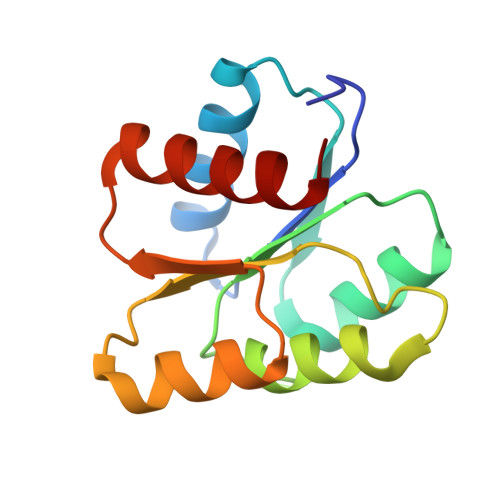A Variable Active Site Residue Influences the Kinetics of Response Regulator Phosphorylation and Dephosphorylation.
Immormino, R.M., Silversmith, R.E., Bourret, R.B.(2016) Biochemistry 55: 5595-5609
- PubMed: 27589219
- DOI: https://doi.org/10.1021/acs.biochem.6b00645
- Primary Citation of Related Structures:
3OLV, 3OLW, 3OLX, 3OLY - PubMed Abstract:
Two-component regulatory systems, minimally composed of a sensor kinase and a response regulator protein, are common mediators of signal transduction in microorganisms. All response regulators contain a receiver domain with conserved active site residues that catalyze the signal activating and deactivating phosphorylation and dephosphorylation reactions. We explored the impact of variable active site position T+1 (one residue C-terminal to the conserved Thr/Ser) on reaction kinetics and signaling fidelity, using wild type and mutant Escherichia coli CheY, CheB, and NarL to represent the three major sequence classes observed across response regulators: Ala/Gly, Ser/Thr, and Val/Ile/Met, respectively, at T+1. Biochemical and structural data together suggested that different amino acids at T+1 impacted reaction kinetics by altering access to the active site while not perturbing overall protein structure. A given amino acid at position T+1 had similar effects on autodephosphorylation in each protein background tested, likely by modulating access of the attacking water molecule to the active site. Similarly, rate constants for CheY autophosphorylation with three different small molecule phosphodonors were consistent with the steric constraints on access to the phosphorylation site arising from combination of specific phosphodonors with particular amino acids at T+1. Because other variable active site residues also influence response regulator phosphorylation biochemistry, we began to explore how context (here, the amino acid at T+2) affected the influence of position T+1 on CheY autocatalytic reactions. Finally, position T+1 affected the fidelity and kinetics of phosphotransfer between sensor kinases and response regulators but was not a primary determinant of their interaction.
Organizational Affiliation:
Department of Microbiology and Immunology, University of North Carolina , Chapel Hill, North Carolina 27599-7290, United States.



















